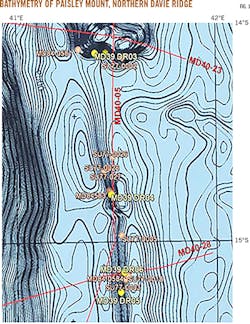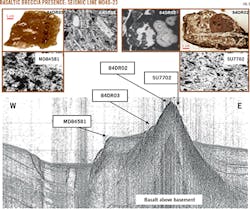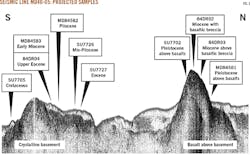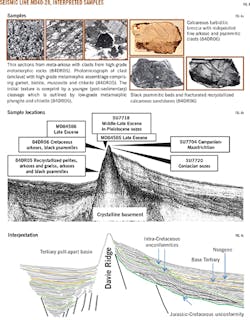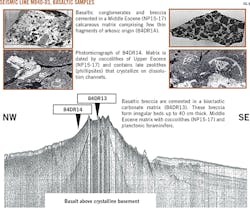Study updates uplift-erosion correlation, Davie fracture zone
Yannis Bassias
Amphore Energy Inc.
Houston
Robert Bertagne
Marex Inc.
Houston
The basins along the eastern African margin and Madagascar contain proven petroleum systems where hydrocarbon discoveries are classified either as stratigraphic traps or as having a combination of stratigraphic and structural components.
The Davie Ridge, a post-Cretaceous expression of the Davie fracture zone (DFZ) may display similar evidence for these petroleum systems or part of them. The understanding of depositional environments is important for identifying potential prospects and seismic imaging alone cannot provide this information as clearly as it does for the structural compenents of geologic traps.
This article synthesizes information derived from a large set of dredging and coring data recovered on the Davie Ridge and its flanks. The results will bring additional confidence to the identification of the Mesozoic and Cenozoic seismic markers as well as to the extent of the uplift and erosion of this fracture zone through time. This article classifies, from north to south, the potential provinces in respect to the uplift and erosion phases that governed the region's sedimentation history to help derisk future exploration.
From an exploration standpoint results point toward conventional production from the Albian sands. The finding that these sands may have been eroded on parts of the structures is a limiting factor, but the sands are also well defined by recent seismic. Several other objectives exist on both flanks of the DFZ, with the western side being the most attractive due to the increased thickness of the sedimentary section.
Historical observation
The Davie Ridge, an exceptional structural feature of the Mozambique channel, was identified in 1970 by the research vessel (R/V) Chain (CH99), and led geologists to suggest that it could represent a fault along which Madagascar was displaced southwards in Late Jurassic.1 Further seismic and magnetic data collected in the late 1970s showed that the breakup between Madagascar and Africa began 150 million years ago, that Madagascar moved southwards, and that the Davie Ridge should correspond to the trace of the transform fault along which Madagascar drifted until the time of anomaly MD (110 Ma).2 3
Site 242, drilled by the Glomar Challenger Leg 25 in 1972, did not reach the basement but the recovered sedimentary column (676 m) is a complete hemipelagic sequence from Late Eocene to Quaternary with a well-defined Eocene-Oligocene boundary.4 Piston cores recovered by R/V Suroit (SU2) in 1977 showed a basal, discontinuous, and thin pelagic sedimentary sequence of Late Cretaceous (Middle Coniacian) age overlaying arkosic sandstones.5 6 Dredging and coring from the R/V Marion Dufresne cruise (MD 39) in 1984 confirmed these results and demonstrated that the ridge is built on continental basement consisting of gneisses and meta-arkoses which locally are covered by a deformed flysch, alkaline lavas, tuffs and breccias, and by a thin succession of carbonate oozes ranging from Cretaceous to present.7 8
Seismic cruises MD 40 and MD 60 provided additional information on the structural setting of the ridge.9 The variety of dredged and cored samples are described and projected for selected seismic lines.
Rock samples
The northern part of the ridge, Paisley Mount around 14°S, offers a WNW-ESE cross section (Fig. 1). At the western flank, fragments of altered aphyric basalt were cored below Pleistocene oozes (MD84581, 2,063 m below sea level [mbsl]). Upslope, decimetric angular blocks of vesicular greenish and reddish basalts and tuffs were recovered (84DR03, 1,831-1,760 mbsl). The basalts are alkaline with plagioclase, K-feldspar, biotite, kaersutite, apatite, and relics of clinopyroxene.
Dredging of basaltic breccia, conglomerates, and Miocene bioclastic limestone (84DR02, 810-800 mbsl) occurred further east. The breccia elements are vesicular alkaline basalts with clinopyroxene phenocrysts set in a groundmass rich in plagioclase, K-feldspar, clinopyroxene, and phillipsite crystallizing in the vesicles. The basaltic elements are reworked and cemented with a bioclastic carbonate matrix rich in planctonic foraminifers of Miocene age. The coring also consists of basaltic glass fragments at the eastern flank of the mounts (SU7702, 1,110 mbsl).
The seismic line is parallel to the cross section and situated around 10 km to the north (Fig. 2). Fig. 3 shows a projection of the dredged and cored material on seismic line MD84-23 and interpretation of the strong reflectors and unconformities east and west of the volcanic mount.
Research expeditions have dredged pelagic sediments with polymetallic crusts (84DR04, 2,255-1,905 mbsl) at the southern portions of Paisley Mount, along with tuffs similar to those from the top of Mount Paisley (Fig. 1). The matrices of the tuffs are green, rarely reddish, without calcite or dolomite, and contain fine basalt fragments.
Coring of sands and arkosic fragments took place updip northwards at the base of Pleistocene oozes (MD84582, 2,025 mbsl). The same location (MD84583, 1,905 mbsl) also features Early Miocene (NN2) oozes with reworked Upper Eocene (NP20) while further to the north Eocene and Miocene-Pliocene sediments cover the sea bottom (SU7726, 2,230 mbsl). At the southernmost part, cores showed calcareous sands of probable Cretaceous age (SU7704, 1,912 mbsl).
Fig. 3 shows a projection of the dredged and cored material on seismic line MD84-05. A tentative interpretation points to the strong reflector and unconformities east and west of the volcanic mount.
The eroded crystalline basement emerges south of Mount Paisley at the base of the western flank of the ridge (84DR05, 2,450-1,950 mbsl) and consists of recrystalized pelites and arkoses with small clasts of gneisses (Fig. 4). A comparable sequence was found further south at 16°S (84DR09). Sandy-clayey carbonates of Late Cretaceous age (SU7704, 1,807 mbsl) and Late Miocene (NN11) oozes (U77-0003, 1,815 mbsl) were sampled above the pelites and arkoses. On the same flank, Coniacian oozes (SU7720, 1,845 mbsl) are associated with reworked arkosic (SU7719, 1,935 mbsl) below Pleistocene oozes, with dredge 84DR06 (1,900-1,875 mbsl) and core MD84585 (1,940 mbsl) recovering fragments of strongly lithified black psammitic beds and of calcareous sandstones (Fig. 4).
The psammitic rocks are blackish flysch-like and appear intensively fractured and strongly recrystallized. These sediments correlate with those from Site 249 (top of Unit III), Site 241 (cores 27-28: Turonian Early Senonian) and Site 250 (cores 24-25: Coniacian) and underlie mid-Cretaceous pelagic sediments or Eocene calcareous sandstones.
Calcareous sandstones from 84DR06 are white to light-brown, variously brecciated or fractured. These rocks, dated by nannoplanktons of Upper Eocene age, are locally bioturbated, dissolved, and covered by thin Mn-oxide layers. They are comparable with those from Leg 25, Site 241 (Cores 27-28) and Site 249 (Units II and III) of Late Cretaceous-Eocene age. Slightly-lithified calcareous breccia contain redeposited fine arkosic and psammitic clasts and are covered by Pleistocene oozes with reworked Middle and Late Eocene nannofauna. These calcareous breccia are covered by thin layers of Mn-oxide.
The breccia contain small, heavily reworked arkosic and large rounded slightly reworked calcareous fragments which are cemented with an Upper Eocene matrix with composition similar to that of the calcareous sandstones. Lithological features such as rounded fragments, mass flows, microslumps, and differential compaction suggest a high energy, depositional environment and turbiditic activity. Angular psammitic fragments of varied dimensions (1 mm - 2 cm) are cemented in a calcareous matrix rich in Fe-Mg oxides.
Samples projected on seismic line MD40-28 demonstrate the amplitude of erosion and of uplift phases of the crystalline basement (Fig. 4). The interpretation of the strong reflectors and unconformities east and west of the crystalline mount suggest that three large erosion phases took place and recent faulting brought the western part of the edifice to a total vertical displacement of around 2 sec (two-way travel time).
At the central part of Mount Macua (16°S, Fig. 5) the eroded crystalline basement rocks are comparable to those found at 15°S (B4DR05 and B4DR06). The sample consists of calcareous breccia with psammitic and arkosic clasts, recrystallized and karstified bioclastic limestones with Miocene planktonic foraminifers, calcareous sandy oozes, and Plio-Quaternary oozes rich in nannofauna (84DR09, 953-700 mbsl) (Fig. 6). To the west, 84DR08 (1,350-860) recovered white Neogene calcareous oozes with arkosic fragments. Further west the sea bottom is covered by brown Neogene calcareous ooze (84DR07, 1,837-1,390 mbsl).
Samples projected on seismic line MD40-32 show again the amplitude of erosion and uplift of the crystalline basement and the large volumes of mass redeposited on the flanks (Fig. 6). The crests of the Sakalaves Mounts (18°S) are covered by Miocene basaltic breccia, rounded and highly altered (84DR10 and 84DR11) (Fig. 7). They were found together with karstified limestones containing Eocene calcareous fragments and with Pleistocene, probably Miocene oozes (Fig. 8). The crests expose Miocene (NN2) oozes and polymetallic oxides (SU7714, 1,240 mbsl) further south. At Mount Antandroy, to the north, cores recovered Late Eocene (NP20) oozes (SU7710, 2,050 mbsl), Early Miocene (NN2) limestone (SU7712, 2,005 mbsl) and oozes with reworked Oligocene (SU7711, 1,920 mbsl).
The southern crests of the Sakalave Mounts between 18° and 19°S are also covered by basaltic breccia (Fig. 8). Irregular beds of basaltic breccia are cemented in a bioclastic matrix rich in Middle Eocene nannoplancton and benthic and planctonic foraminifera (84DR13, 600 mbsl). Basalt clasts, up to 1 cm, are composed of diopsidic clinopyroxene, K-feldspar, and later hematite. They are oxidized and give a reddish color to the rock.
Further south and downdip, soft blocks of altered basaltic breccia are cemented in a chalk matrix containing few fresh dark-green vesicular clinopyroxene-phyric basalt fragments (84DR14, 1,130 mbsl). Nannoplanctons of Middle Eocene (NP15-17) dated the matrix of these breccia. Nannofauna shows some dissolution and slight recrystallization. These breccia, as those from the top of the Mounts (84DR13), correlate with those from distinct horizons of DSDP Site 245 (Unit II) of Middle Eocene age.
Metamorphism, uplift, and erosion
The crystalline basement rocks crop out at the median parts of the ridge. Basalts were not encountered below pelagic sediments at these latitudes, confirming the absence of magnetic signature.10
As erosion products of crystalline provinces, these rocks could be an intimate part of the basement, having been deposited during the early rifting which preceded the southwards drift of Madagascar along the DFZ. These rocks are comparable with several formations from the African basement and related Karoo facies known in Tanzania and the Malagasy craton.
From fracture zone to ridge
Local distensions along the DFZ during Cretaceous induced either the first Cretaceous pelagic sedimentation or hypabyssal to subaerial volcanic activity with intense hydrothermalism. A major Cretaceous unconformity developed on both flanks of the ridge, yielding two important features:
• The spatial symmetry of the volcanic activity, present at the northern and southern parts of the ridge.
• The Late Cretaceous and Eocene sedimentation, prominent at the median and southern parts of the ridge.
These features suggest that during Late Cretaceous and Eocene the local distensions accompanying lithospheric fissuring were transgressive southwards while the northern part of the ridge remained close to sea level for a long period. Eocene outcrops are, in fact, better exposed at the southern parts of the ridge.
The products of this erosion settled on the flanks of the ridge and their imprint is often recognizable as lenses-forms on the seismic above the major unconformity. Paleocene is absent on the ridge and was not drilled by Glomar Challenger Leg 25, thus the major unconformity has to be considered of Cretaceous to Paleocene age.
Sedimentation, volcanic activity
Variations of the Cretaceous sedimentary environments are well documented at the median parts of the ridge (SU7704, SU7720, 84DR06, 84DR09). The oldest known pelagic sediments of the Davie Ridge are Late Cretaceous oozes. These sediments locally cover the eroded crystalline basement and in two cases were dated of Middle Coniacian (SU7720) and Upper Campanian to Maastrichtian (SU7704). They are particularly soft, supporting the hypothesis that subsidence associated with overlying sediments was limited at the median parts of the ridge.
The volcanics are present in both northern and southern parts of the ridge below Eocene pelagic sediments and above eroded crystalline basement, consistent with the presence of magnetic signatures. Basalts are alkaline aphyric or phenocrystic rocks emplaced under hypabyssal, and in some cases, subaerial conditions. The absence of mylonitic texture in the basalts may suggest absence of stress and low-temperature deformation during emplacement and absence of transform fault movements. The absence of pillow features and of ultrabasic rocks discounts transition between oceanic and continental crust, indicating that the volcanic activity of the ridge appeared on a continental setting after cessation of the southwards movement of Madagascar.
The geochemistry of the volcanics shows mixing between a differentiated basaltic melt situated in shallow depths and a sialic component, suggesting the influence of subcontinental lithosphere.8 These volcanics are chemically and petrogenetically comparable with the Early Cretaceous volcanism along the southeastern margin of Africa and penecontemporaneous with the Late Cretaceous volcanic activity of western Madagascar which preceded or accompanied local distensions. They coincide with the initiation of the transcurrent motion between India and Madagascar at 83 Ma (Anomaly 34) and with the subsequent northwards movement of India.
Submarine hydrothermalism under reducing conditions variously affected the basalts. This period was associated with or followed by brecciation and tuffs sedimentation. Basalt samples collected are variously affected by sea water and have alteration features such as oxidation colors and vesicles filled with either carbonate or green-layered lattice silicate minerals. Pressures were probably lower than 3 kilobar and temperatures between 150° and 200° C.
Miocene-Pliocene time gap
The Miocene bioclastic limestones rich in planktonic fauna are commonly found on the crests of the ridge, where they enclose basaltic fragments and lie between Mn-oxide layers. These formations were probably exposed to subaerial alteration. The breccia from the western flank are composed of rounded fragments and this suggests deposition at some distance from the source while those from the crest consist of angular fragments and suggest in situ deposition. The missing Oligocene, equally absent in several sites of the Indian Ocean, may represent this unconformity, recognizable on the seismic by a strong and thin reflector.
The fact that Miocene bioclastic limestones and breccia from the crests of the ridge are locally karstified, fractured, and directly covered by younger Pleistocene chalks, suggests fault-controlled tilting, emersion, and erosion along the ridge during Miocene and records an important stratigraphic hiatus which might be related with a large tectonic activity or mersion before the sedimentation of the Pleistocene chalks. The Upper Pleistocene oozes (NN 19/20) from the flanks of the ridge contain significant proportions of reworked Upper Eocene nannofauna, suggesting that the Miocene-Pliocene time gap on the crests is a period of non-consolidation where sediments were reworked several times due to tilting and differential subsidence.
A generalized pelagic sedimentation is established after this late erosion and the ridge is covered by white, soft oozes and lumashelic chalks. These formations are rich in debris of gastropods and echinoids as well as in benthic and planktonic foraminifers cemented in a Pleistocene nannoplankton matrix.
Updated correlation
This article shows the need for major correlation changes, on both the eastern (Malagasy) portion and the western (Mozambican) portion of the DFZ, and yields the following conclustions:.
• Mio-Pliocene is thinner than expected.
• Oligocene may be absent (probably on the Malagasy side).
• Eocene is thin and may be absent on certain portions of the DFZ.
• Upper Cretaceous is thicker than expected.
• Turonian and Albian are apparently present on all parts of the DFZ.
• The Albian sands which are producing in western Madagascar (West Manambolo-1) seem to be well developed (500-850 m) and constitute a major objective.
The DFZ appears to have assumed its structural character mostly during Late Cretaceous (Coniacian, Santonian) which was followed by a long hiatus. The erosion of the ridge seems to be localized and the presence of well-defined depositional channels in the Tertiary is not readily apparent, most likely because a good part of the DFZ was emergent for a long time.
Acknowledgments
This information is a compilation of reports, publications and studies on 63 piston cores and 15 dredge hauls, among 119 samples, recovered during the R/V Marion Dufresne cruise (MD39) in 1984 and the R/V Suroit cruise (SU2) in 1979. Cruise MD39 was funded by the Territoire des Terres Australes et Antarctiques Francaises in 1984. More than one ton of dredged rocks from the Davie Ridge are preserved in the Lithotheque Marine of the National Museum of Natural History in Paris. Seismic was courtesy of CNRS-IPGS/GeoAzur. This synthesis completes previous work of one of the authors, Yannis Bassias, on the crystalline basement and the Cretaceous volcanism of the DFZ.
References
1. Heirtzler, J.R., and Burroughs, R.H., "Madagascar's paleoposition: New data from the Mozambique Channel," Science, Vol. 174, No. 4008, October 1971, pp. 488-490.
2. Segoufin, J., "Anomalies magnétiques mésozoïques dans le bassin de Mozambique," Comptes Rendus de l'Académie des Sciences, Vol. 287, 1978, pp. 109-112.
3. Segoufin, J., and Patriat, P., "Existence d'anomalies mésozoïques dans Ie bassin de Somalie. Implications pour les relations Afrique- Antarctique-Madagascar," Comptes Rendus de l'Académie des Sciences, Vol. 291, 1980, pp. 85-88.
4. Simpson, S.W., Schlich, R., et al, "Site 242: Initial Reports of the Deep Sea Drilling Project," Vol. 25, May 1974.
5. Segoufin, J., Leclaire, L., and Clochiatti, M., "Les structures du canal de Mozambique. Le problème de la ride de Davie," Annales de la Societe geologique du Nord, Vol. 97, Fourth quarter, 1978, pp. 309-314.
6. Fellah, N., "Nannofossiles calcaires et stratigraphie de la couverture sédimentaire des rides de Davie et du Mozambique dans l'océan Indien," Thèse 3eme cycle, University of Paris VI, Vol. 228, 1981, p. 18.
7. Leclaire, L., "Late Cretaceous and Cenozoic pelagic deposits. Paleo-environment and Paleo-oceanography of the Central Western Indian Ocean," Initial Report of the Deep Sea Drilling Project, Vol. 25, May 1974, pp. 481-512.
8. Bassias, Y., and Leclaire, L., "Crystalline basement and intraplate mesozoic magmatism of the Davie Fracture Zone," Neues Jaarbuch fur Geologie und Palaontologie Mh., Vol. 2, 1990, pp. 67-90.
9. Mougenot, D., Recq, M., Virlogeux, P., and Lepvrier, C., "Seaward extension of the East-African rift," Nature, Vol. 321, June 1986, pp. 599- 803.
10. Segoufin, J., and Patriat, P., "Reconstruction de l'Océan Indien occidental pour les époques des anomalies M-21, M-2 et M-34: Paléo-position de Madagascar," Bulletin de la Societe Geologique de France, XXIII, No. 6, 1981, pp. 603-607.
The authors
Yannis Bassias ([email protected]) is president of Amphore Energy Inc., Houston. Before joining the petroleum industry he was associate professor in the National Museum of Natural History, Paris. He holds a PhD (1984) from the University Pierre et Marie Curie, Paris VI. He is a member of the American Association of Petroleum Geologists, the Society of Exploration Geophysicists, the Petroleum Exploration Society of Great Britain, and the Association of International Petroleum Negotiators.
Robert Bertagne ([email protected]) is president of Marex Inc., Houston. Prior to joining Marex, he served in various technical and managerial positions with several majors and independent oil companies.

